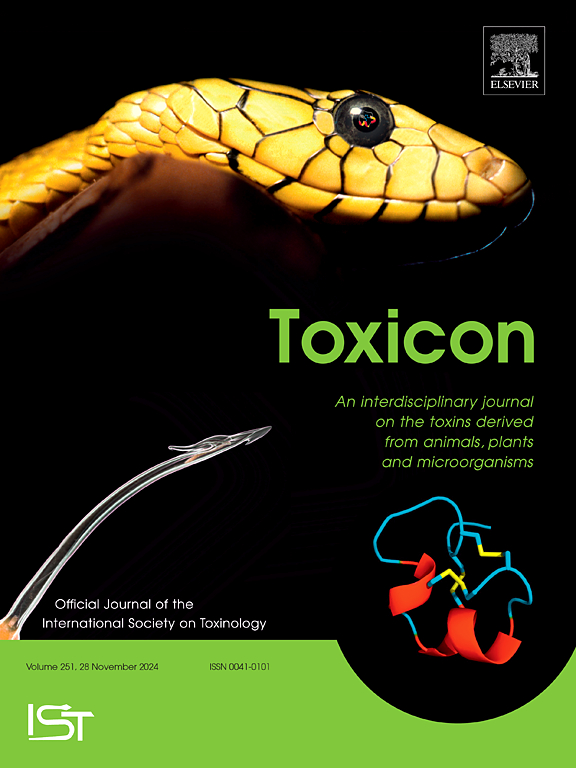Melittin: A promising therapeutic agent for rheumatoid arthritis treatment
IF 2.6
4区 医学
Q2 PHARMACOLOGY & PHARMACY
引用次数: 0
Abstract
Rheumatoid Arthritis (RA) is a globally prevalent chronic disease that presents significant challenges in terms of curability. The etiology and onset of RA are not readily identifiable, and as the disease advances, it is characterized by joint pain, swelling, and damage, potentially resulting in paralysis. The adverse effects associated with existing pharmacological treatments are considerable, and prolonged use may pose significant health risks. Melittin, a naturally occurring anti-rheumatic compound, has garnered increasing scholarly interest. Melittin has demonstrated the potential to significantly augment the therapeutic efficacy of certain first-line pharmacological agents while minimizing adverse effects, thereby rendering it appropriate for prolonged use. Melittin's mechanisms of action in treating RA encompass anti-inflammatory effects, immunomodulatory effects, analgesic effects, reduction of cardiovascular disease risk, and organ-protective effects, targeting multiple aspects of RA to alleviate symptoms. Clarifying the biological functions of melittin and its mechanisms in treating RA can provide valuable insights for the application of melittin in the intervention of RA disease progression. However, melittin can cause allergic reactions, hemolysis, and cytotoxicity in the body, which limit its application. Research has shown that strategies including melittin-based nanomodification, immunoconjugation, and structural regulation can improve the specificity of melittin, decrease cytotoxicity, and mitigate the lytic effects on non-target cells of bee venom. These findings suggest that melittin holds promise for clinical applications. This article provides a comprehensive overview of the disease progression associated with RA, examines the biological properties of Mmelittin, and discusses therapeutic strategies for utilizing melittin in the treatment of rheumatoid arthritis. The objective is to mitigate the toxic side effects of melittin while enhancing its targeted anti-inflammatory effects, thereby investigating its potential clinical value in the prevention of rheumatoid arthritis.

蜂毒素:一种治疗类风湿关节炎的有前途的药物。
类风湿性关节炎(RA)是一种全球流行的慢性疾病,在可治愈性方面提出了重大挑战。类风湿性关节炎的病因和发病不容易确定,随着疾病的进展,其特征是关节疼痛、肿胀和损伤,可能导致瘫痪。与现有药物治疗相关的不良影响相当大,长期使用可能造成重大健康风险。蜂毒素是一种天然的抗风湿病化合物,已经引起了越来越多的学术兴趣。蜂毒素已被证明有潜力显著提高某些一线药物的治疗效果,同时将不良反应降至最低,因此适合长期使用。蜂毒素治疗RA的作用机制包括抗炎作用、免疫调节作用、镇痛作用、降低心血管疾病风险和器官保护作用,针对RA的多个方面缓解症状。阐明Melittin的生物学功能及其在RA治疗中的作用机制,可以为Melittin在RA疾病进展干预中的应用提供有价值的见解。然而,蜂毒素在体内会引起过敏反应、溶血和细胞毒性,这限制了它的应用。研究表明,基于蜂毒蛋白的纳米修饰、免疫偶联和结构调节等策略可以提高蜂毒蛋白的特异性,降低蜂毒蛋白的细胞毒性,减轻蜂毒蛋白对非靶细胞的裂解作用。这些发现表明,Melittin具有临床应用前景。本文提供了与类风湿性关节炎相关的疾病进展的全面概述,检查了Melittin的生物学特性,并讨论了利用Melittin治疗类风湿性关节炎的治疗策略。目的是减轻蜂毒素的毒副作用,同时增强其靶向抗炎作用,从而探讨其在预防类风湿性关节炎方面的潜在临床价值。
本文章由计算机程序翻译,如有差异,请以英文原文为准。
求助全文
约1分钟内获得全文
求助全文
来源期刊

Toxicon
医学-毒理学
CiteScore
4.80
自引率
10.70%
发文量
358
审稿时长
68 days
期刊介绍:
Toxicon has an open access mirror Toxicon: X, sharing the same aims and scope, editorial team, submission system and rigorous peer review. An introductory offer Toxicon: X - full waiver of the Open Access fee.
Toxicon''s "aims and scope" are to publish:
-articles containing the results of original research on problems related to toxins derived from animals, plants and microorganisms
-papers on novel findings related to the chemical, pharmacological, toxicological, and immunological properties of natural toxins
-molecular biological studies of toxins and other genes from poisonous and venomous organisms that advance understanding of the role or function of toxins
-clinical observations on poisoning and envenoming where a new therapeutic principle has been proposed or a decidedly superior clinical result has been obtained.
-material on the use of toxins as tools in studying biological processes and material on subjects related to venom and antivenom problems.
-articles on the translational application of toxins, for example as drugs and insecticides
-epidemiological studies on envenoming or poisoning, so long as they highlight a previously unrecognised medical problem or provide insight into the prevention or medical treatment of envenoming or poisoning. Retrospective surveys of hospital records, especially those lacking species identification, will not be considered for publication. Properly designed prospective community-based surveys are strongly encouraged.
-articles describing well-known activities of venoms, such as antibacterial, anticancer, and analgesic activities of arachnid venoms, without any attempt to define the mechanism of action or purify the active component, will not be considered for publication in Toxicon.
-review articles on problems related to toxinology.
To encourage the exchange of ideas, sections of the journal may be devoted to Short Communications, Letters to the Editor and activities of the affiliated societies.
 求助内容:
求助内容: 应助结果提醒方式:
应助结果提醒方式:


